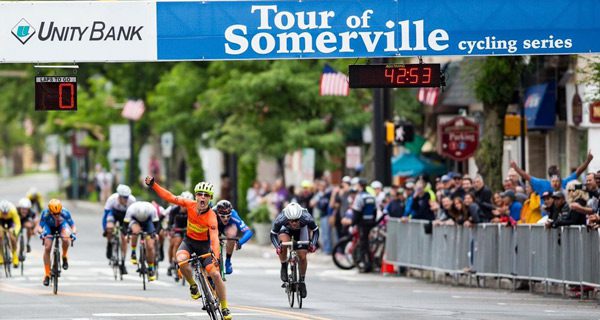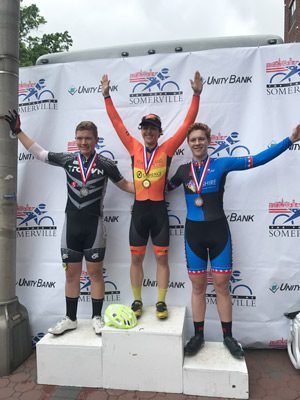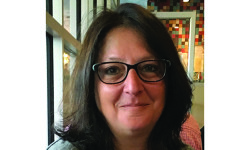[ccfic caption-text format="plaintext"]
By Lisa Moore
Hometown Weekly Correspondent
Becoming a professional cyclist requires passion, skill, and determination. Committing to the demanding training regimen of riding between 1 and 4 hours a day, and the expense of equipment, travel, and race fees is just the beginning. A rider must advance through the six levels of racing in the US to reach the level of Pro. Starting as a category 5, riders must race each season to finish among the top five finishers, winning and scoring points towards their individual rankings.
For riders who are serious and working towards becoming a professional cyclist, the journey usually takes 5-6 years to achieve Category 2 status, with many riders never able to advance past that level.
For Wellesley 18-year-old Alexander Chrystall, who began riding and racing in 2014, his rise from Cat 5 to Cat 1 has taken only three years. This August at the Raw Seafood Criterium race in RI, Alexander, known as Zander, finished first in the hour-long race and gained the final points he needed to reach the rank of Cat 1. The new ranking brings him to the precipice of professional cyclist level.
In the US, there are four different types of races cyclists can compete in during the racing season. There is mountain bike racing, where the racecourse is off road, and road racing, where the race is along streets and roads with a minimum racing distance of 80 miles. There is criterium racing, or “crit,” which is oval racing usually done on a closed loop of street approximately 1 mile long. In crit races, racers ride very fast over many laps. This type of race is timed and can be 70 to 90 minutes long. Finally, cyclocross racing in winter is a hybrid between road, crit and mountain bike races. This type of event is held in a field or park, where the race loop challenges riders with different types of terrain and obstacles to navigate.
Each type of racing requires different bicycles to handle the unique conditions for each race. Mountain bike races require a bike with thick knobby tires that can handle the off road terrain, criterium and road races require a light bike that has thin, dense racing wheels, and cyclocross requires a hybrid type of bike, one that is lightweight with a thick knobby tire.
Many people think cycling is an individual sport, but in reality in order for a rider to be successful, they need the help and support of a team. Zander rides with the team New England Development and is coached by Adam Myerson of Dorchester, who himself is a prolific professional rider in crit and cyclocross and is the current road race national champion. New England Development is a team with junior riders aged 15 to 18 and senior riders that mentor and aid junior riders, helping them to finish in first place. Team members are there to loan spare bikes or parts, help a teammate draft to conserve energy to slingshot past opponents, and chase down a stray rider attempting to pull away from the pack.
In addition, parents play a huge supporting role on the team, ensuring the junior riders get to the start of each race on time and have adequate food and water at the food and water zone. They also act as “sweepers,” finding lost riders that strayed off course and collecting each rider and all of their gear at the end of a race - sometimes 80-plus miles away from the start. A strong team will make every rider stronger.
For Zander, his biggest motivator and best teammate has been his father, who he credits with pushing him when he needed it, helping him to become a better rider, and inspiring him to work harder to advance through the ranks to achieve Cat 1. A rider himself, Douglas Chrystall has been there to support Zander, often riding along with him on his long training days, cycling 80-plus miles together.
Now that Zander has achieved Cat 1 status in criterium and road races, he is working toward a new goal: turning pro.
“The important thing is to set a goal and strive forward to achieve that goal. Cycling takes motivation to move forward; it is a physically and mentally challenging sport,” he said. This winter, Zander hopes that with his coach’s support, he will be signed to a professional racing team. Life for a pro cyclist is a life on the road with lots of travel, a prospect that has Zander feeling “super-excited and a little nervous. I really want to keep moving forward. Each new level I reach is more challenging, a chance to race against other great riders, and a chance to become a better rider.
“I love the sprinting at the end of the race,” he continued, reflecting on his favorite part of cycling. “The thrill and adrenaline of the speed, and sprinting against the pack of riders the last 200-500 meters of the race.”
As a junior rider, Zander currently races under a gear restriction - a rule that is in place to protect the knees and joints of young riders. When he turns 19, he will be free to use all the gears for racing. “I am looking forward quite a lot to sprinting without the gear restriction”, he said.
As Zander prepares for the next level of cycling, he had this to say for younger riders: “You need to have a partner or mentor on the bike with you, to push you, and motivate you so you can grow in the sport faster and achieve higher goals more quickly.”























